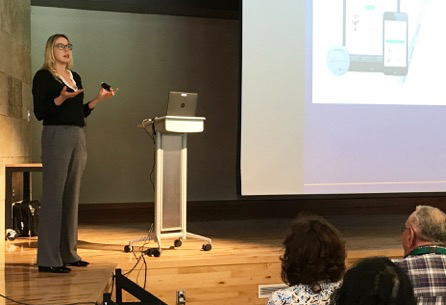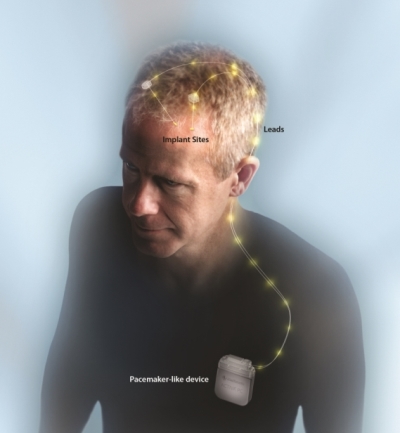DBS Helps Control Involuntary Tremors, Says Dr. Beasley
- Category: General, Neurology/Neurosurgery, Surgery
- Posted On:
- Written By: Boulder Community Health

For about 11 million Americans, involuntary tremors are a constant problem that can interfere with just about everything — getting dressed, drinking a cup of coffee or using a cell phone. This trembling can be caused by Parkinson’s disease, but more often it’s caused by Essential Tremor, a benign, often inherited condition.
“There are no cures for these neurological movement disorders. Treatments include medication and surgical therapy,” BCH neurosurgeon Kara Beasley, DO, of Boulder Neurosurgical & Spine Associates told a crowd of more than 230 people during a free health lecture held on Aug. 24 at the Boulder Jewish Community Center.
“Deep brain stimulation is a surgery that can help treat the debilitating symptoms of Essential Tremor or Parkinson’s disease when medication fails to provide consistent and adequate symptom control,” said Dr. Beasley.
Symptoms of Essential Tremor
Essential Tremor is the most common neurological movement disorder, affecting up to 20 percent of elderly people. Tremors associated with this non-life-threatening condition can cause rapid, uncontrollable
• shakiness of the hands – the most common symptom.
• small up-and-down or side-to-side head shakes.
• tremors of the tongue or voicebox that can make your voice sound shaky.
• leg and feet shakes that can affect balance or the way you walk.
Tremors can occur for brief periods of time or constantly, and don’t cause any serious health problems.
Symptoms of Parkinson’s Disease
Parkinson’s disease is the second most common movement disorder, affecting more than 1 million Americans. It is a progressive disease with symptoms that develop gradually and worsens over time. They include:
• slow muscle movement.
• tremor that usually begins in hands or fingers.
• rigidity and muscle stiffness, limiting range of motion.
• posture instability, which can cause balance problems.
• walking problems characterized by small shuffling steps or hesitation before stepping forward.
Parkinson's disease itself is not fatal. However, complications from the disease are serious and make it the 14th top cause of death in the U.S. People with Parkinson's who seek expert care are at a lower risk of complications, have a better quality of life and even live longer, according to the National Parkinson Foundation.
DBS: A Pacemaker for the Brain
Deep brain stimulation (DBS) is a brain surgery for patients with Essential Tremor or Parkinson’s disease. It is personalized for a patient's unique brain anatomy, particular symptoms and specific disease.
The procedure involves implanting a device often described as a “pacemaker for the brain.”

“There are two stages to the surgery. In the first stage, the surgeon implants electrodes on specific areas of either one side or both sides of the brain,” Dr. Beasley explained. “In the second stage, the neurosurgeon implants a pacemaker-like neurostimulator under the skin, near the collarbone, and connects it to the electrodes with long lead wires passed under the skin and along the neck.”
She said, “The stimulator sends constant high-frequency electrical impulses to the electrodes, which block the abnormal nerve signals causing the tremors.”
What are the Results of DBS?
For the treatment of Essential Tremor, DBS typically targets hand tremors. Clinical studies show that it can reduce hand tremor in 60 to 90 percent of Essential Tremor patients, improving their ability to do everyday activities.
Although it won’t slow the progression of Parkinson’s disease, DBS can significantly reduce the symptoms of tremor, rigidity, stiffness, slowed movement, and some types of walking problems. Results show that more than 70 percent of patients with Parkinson’s disease experience significant improvements to their motor function.
“Yet to obtain maximum benefit from DBS, patients must receive treatment during a window of opportunity when it can be the most effective,” Dr. Beasley warned.
If you wish to learn more about DBS or to determine whether you’re a candidate for the procedure, schedule an appointment with Kara Beasley, DO, by calling 303-938-5700.
Click here to view PowerPoint slides from Dr. Beasely’s lecture on “Controlling Involuntary Tremors.”
Want to receive notification of special events and lectures? Sign up to receive email notifications.